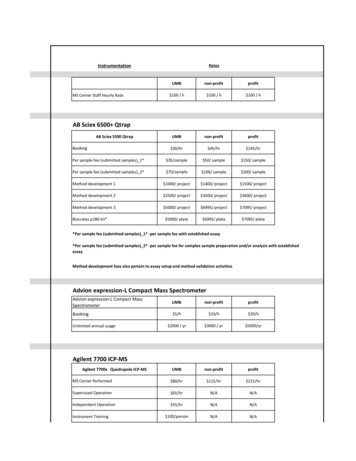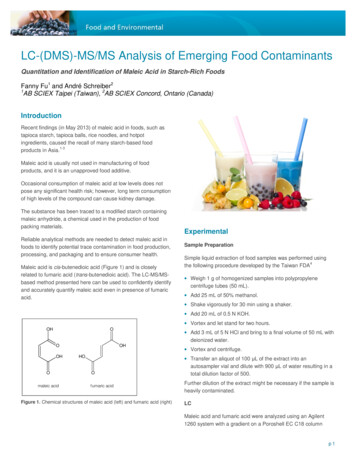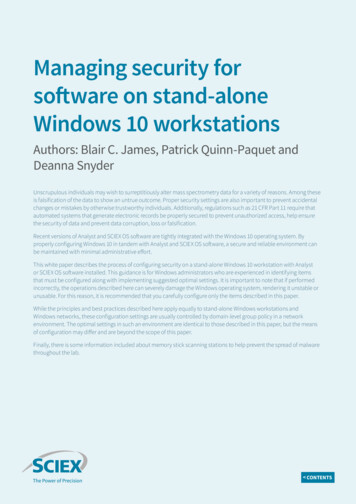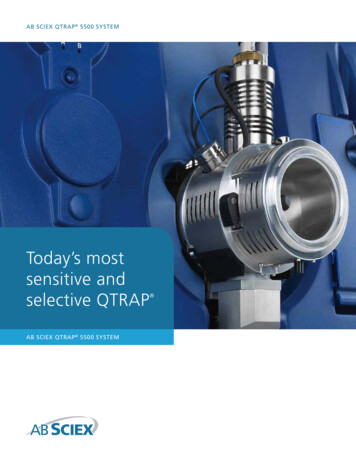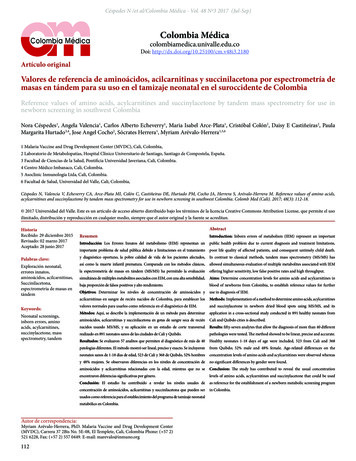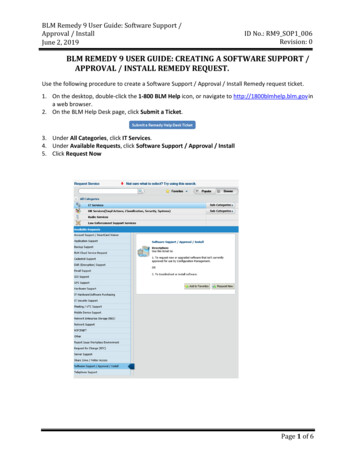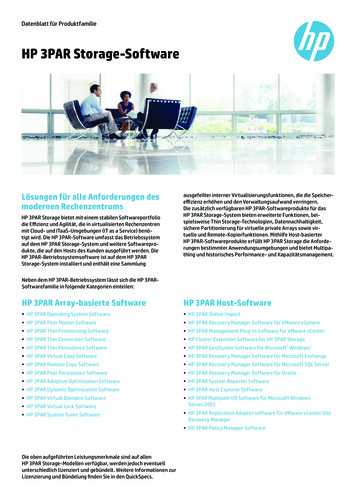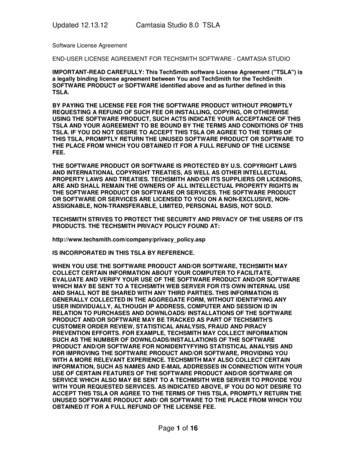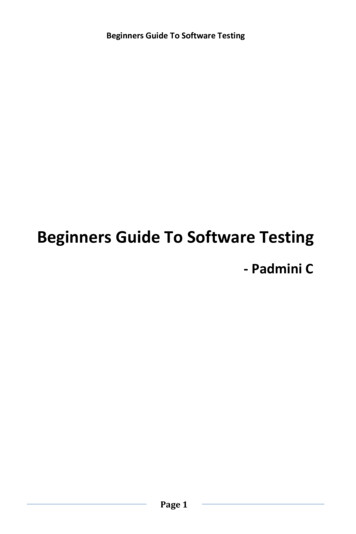
Transcription
SCIEX OS LC/MS Software and 21 CFR Part 11 RegulationsAuthor: Blair C. JamesPurposeThe purpose of this paper is to present an approach to assist the userin achieving 21 CFR Part 11 compliance with SCIEX OS LC/MS softwareversion 1.4 and above, when used for quantitative analyses supportingGood Laboratory Practice (GLP) bioanalytical studies. In this paper, weoutline the joint responsibilities between a supplier and its customersto support users’ 21 CFR Part 11 compliance. We hope you find theinformation both helpful and educational.Introduction21 CFR Part 11 is a US Food and Drug Administration (FDA) regulationthat covers the trustworthiness and reliability of electronic records andelectronic signatures. The regulation has been effective since August20, 1997 and has since been reviewed and supplemented withadditional guidance. On February 20, 2003, the agency issued a draftGuidance for Industry on Part 11 Scope and Applicability and, after a60-day industry comment period, issued the final version onSeptember 3, 2003.2 This paper incorporates content from both theinitial regulation and the final version of the Guidance for Industry. InApril, 2016, the FDA issued a draft of “Data Integrity and Compliancewith cGMP Guidance for Industry.” The data integrity guidance isorganized as a series of questions and answers and is helpful wheninterpreting 21 CFR Part 11 in the context of modern computerizedsystems. This paper is not intended to provide legal advice or interpretthe law. For a complete statement of terms, reference should be madeto the regulation and the complete Guidance for Industry.ContentsWe will discuss the following issues of 21 CFR Part 11 and how SCIEXOS can be configured to help meet the regulatory requirementsassociated with the underlying GLP predicate rule (21 CFR Part 58). What is 21 CFR Part 11? A brief history and current status ofthe regulation Discussion of open and closed systems in the context of SCIEX OS Controls required for 21 CFR Part 11: technical, administrativeand procedural Impact of predicate rules for the interpretation of Part 11 Detailed discussion of 21 CFR Part 11 and certain responsibilitiesfor each section in the regulationtake advantage of modern technology and reduce the use of paper.Following the publication of a draft of the regulation in 1994, thefinal rule was published on March 20, 1997, and became effective onAugust 20, 1997.In essence, the regulation provides the basis for the use of electronicrecords in place of paper records as well as the use of electronic,rather than handwritten signatures. Under 21 CFR Part 11, electronicrecords can be equivalent to the paper records required by predicateregulations (e.g. 21 CFR Part 58, the Good Laboratory Regulations).3Electronic signatures can be considered as legal equivalents tohandwritten signatures. The regulation further stipulates that bothelectronic signatures and electronic records must be trustworthyand reliable.The regulation impacts almost all FDA-regulated work(e.g. pharmaceuticals, medical devices, blood banks, food).It impacts bioanalysis directly when studies are used to supportnew drug applications or new formulations of existing drugs. Anyorganization that wishes to register products for sale in the USA,regardless of where the organization is based, must comply withthe requirements of this regulation.Key Requirements of 21 CFR Part 11A summary of significant requirements of the regulation appearsbelow. For more detailed explanations, including roles andresponsibilities, please see the later sections of this paper.Please refer to the regulations themselves for a complete statementof these requirements.Electronic RecordsElectronic records (covered by Part B of the regulation) generated byany computerized system must be trustworthy and reliable. A numberof controls are specified in the regulation to support this requirement. Systems must be validated Audit trails are required to monitor creation of and changes torecords, including archive or deletion of data People using a system must be trained; this includes all levelsof support from system administration to front line users and ITsupport staff What is 21 CFR Part 11?Records must be protected for the duration of the recordsretention period; this may be up to 15-20 years depending on thepredicate rule, and for practical purposes can be considered to bepermanent An important driver for the “Electronic Records; Electronic Signatures”Final Rule1 was the pharmaceutical industry, who approached theFDA with a request to use electronic records so that the industry couldSystems must provide the data and associated meta data to aninspector if required Signing of records requires the name of the individual, reason forsigning, and the date and time displayed at the time of signingDefinition of electronic records and how this is interpreted forSCIEX OSRoles and responsibilities for 21 CFR Part 11 compliance: theimportance of partnership between the customer and the supplierSystems must be able to detect altered and invalid recordsOnly authorized individuals must have access to a system and theiraccess levels must align with their assigned responsibilities
Signatures must be linked to respective records so that thesignatures cannot be removed or copied Policies must be established holding individuals accountable foractions taken under their electronic signatures11.10(a) Validation 11.10(d) Limiting system access toauthorized individualsWhere data confidentiality is required, the addition of securitysuch as file encryption or digital signatures is required toensure confidentiality11.10(f) Use of operational systemchecks11.10(b) Copies of records The system, including training and resultant records, must besufficient to prevent repudiation of electronic signatures asnot genuine11.10(g) Use of authority checks11.10(c) Record Retention11.10(h) Use of device checks11.10(e) Audit trail11.10(i) Persons have theeducation, training, andexperience to perform theirassigned tasksLegacy Systems operatingbefore August 20, 1997Part 11 RequirementsStill EnforcedElectronic SignaturesPart C of the regulation has many requirements for procedural andadministrative controls, with relatively few technical requirements.While the use of electronic signatures is voluntary, and each companycan choose to implement electronic signatures or not, there are alsopertinent security requirements for the trustworthiness and reliabilityof electronic records; for example, the ability to detect unauthorizedaccess to a system in §11.300(d).11.10(j) Written policies thathold individuals accountablefor actions11.10(k) Appropriate controls oversystems documentationThe main requirements are: Individuals using electronic signatures must have their identitiesverified Companies must send a letter to the FDA certifying that whenelectronic signatures are used, they are the legal equivalent oftraditional handwritten signatures Electronic signatures must be unique to an individual and neverreused by a company Controls must be in place to prevent fraud (Fraud would requirethe collaboration of two or more individuals) The system must be able to detect attempts of unauthorizedaccess and notify the appropriate security/management staffImpact of the Part 11 Scope and ApplicabilityGuidanceSince 2002, the FDA has been re-evaluating the Good ManufacturingPractice (GMP) regulations and as part of this program,2 five keysections of the Part 11 regulation include enforcement discretion(Table 1).For example:Part 11 Requirements withEnforcement Discretion11.30 Controls for open systems11.50 Signature manifestations11.70 Signature / record linking11.100 General requirements11.200 Electronic signaturecomponents and controls11.300 Controls for identificationcodes/passwordsTable 1. Enforcement discretion. Note that the remainder of 21 CFR Part 11 is still inoperation and will be enforced by the FDA as shown in this table.Impact of 21 CFR Part 11 on BioanalyticalLaboratoriesWhen the regulation became effective, no LC/MS systems operating inbioanalytical laboratories were fully compliant with the requirements.Typical problems included:Validation of Part 11 requirements No audit trail—only a history log in the data file Little or no security (security features if available were difficult touse efficiently and effectively) File overwriting, with or without warning Changes of data could be made with no record of theoriginal value No electronic signatures (while not a compliance problem, per se,this impaired the usefulness and benefit of an electronic system)Copies of recordsRecords retentionAudit trailLegacy systems (i.e., systems already in operation before August20, 1997) do not need to comply with 21 CFR Part 11 regulations,provided they were validated to meet the applicable predicate rulerequirements before Part 11 was in effect and any changes do notinvalidate their ability to meet predicate rule requirements.LC/MS instruments were used as hybrid systems; meaning thatalthough they generated electronic records, handwritten signatureswere applied to paper copies of the records.
Key Part 11 Definitions ExplainedOpen and closed systems21 CFR Part 11 classifies computerized systems as either “open”or “closed” in Part A (Scope section); there are only two words ofdifference between the two definitions (in parentheses below):Closed (Open) system means an environment in which system access is(not) controlled by persons who are responsible for the content ofelectronic records that are on the system.The key points of this definition are: The regulation refers to a “system,” an application is notmentioned; in fact, there is no place in the regulation thatmentions application. “System” includes hardware, software,people, training policies, etc. “System” is given a wide definition, and includes the informationtechnology (IT) network that traditionally was not included inregulatory inspections prior to the issuance of 21 CFR Part 11SCIEX OS is Designed for Closed SystemsCurrent SCIEX OS software can be used in either a closed or opensystem. However, it can be configured to support compliance onlyin a closed system. It can be used within an organization either as astandalone or single system (Figure 1) or in a networked configuration(Figure 2) where multiple acquisition workstations and data processingstations may be connected to a closed network. For the rest of thispaper, we will only consider closed systems.SCIEX OS organizes and stores its data in a “root directory”, locatedon the local acquisition workstation hard drive. Workstations hostingSCIEX OS may be connected to a network, and utilize the network’suser management and credentials verification, but the root directoryshould not be located on a network drive. When processing (quantifying) data, SCIEX OS has the ability to open a raw data file from anyvisible storage location.Figure 1. Standalone SCIEX OS software systems in a laboratory.Networked SystemsTo assist in managing user credentials, SCIEX OS may be connected toa Microsoft Windows Active Directory network. It is important to notethat the networking of several SCIEX OS systems supported by anIT department does not mean that the system is now open.Interpretation of “environment” needs to be wider than just thelaboratory, and encompasses the wider organization, includingcontrolled network objects such as network data storage locationsand data transmission lines. Whether standalone or connected to anetwork, SCIEX OS systems must have written procedures anddocumented evidence that protection of records (backup) isundertaken regularly and reliably.Standalone or single systems?One or several standalone SCIEX OS systems in a bioanalyticallaboratory are closed systems. The facility will have physical securityand there will be logical security to prevent unauthorized persons fromgaining access to the application.Standalone workstations (or network computers, for that matter) thathold electronic records present the risk of disk failure or corruptionof records and require regular backups to support preservation of theelectronic nFigure 2. Networked SCIEX OS software LC/MS systems with the Active Directorynetwork managing user credentials.
Electronic Records“Electronic record” is defined in the regulation:Electronic Record means any combination of text, graphics, data, audio,pictorial, or other information representation in digital form that iscreated, modified, maintained, archived, retrieved, or distributed by acomputer system.1Electronic signatures that can be used under Part 11 are one of thefollowing three types: This is a very broad definition. The phrase “other informationrepresentation” covers any electronic record in any format. The Guidance on Part 11 Scope and Application 2 narrows the scope ofthe regulation in certain circumstances. It still allows the use of paperrecords, if the paper output meets the requirements of the applicablepredicate rules. It is often not practical to define the paper records forthe raw data output of SCIEX OS due to the number and volume ofrecords that the software generates with each run. In the context ofSCIEX OS, the electronic records produced during a bioanalytical runconsist of the LC/MS raw data: LC/MS data files – single sample in a single WIFF file, multiplesamples within a single WIFF, combinations of multiple samples,and multiple WIFF files Quantitation results tables including the audit trail incorporatedwith each results table Processed data file(s)›› Eliminate character-composition requirements›› Eliminate mandatory periodic password resets foruser accounts›› Ban common passwords, to keep the most vulnerablepasswords out of your systemAudit trails and history logs›› Educate your users not to re-use their password fornon-work-related purposesAcquisition method file›› Enforce registration for multi-factor authenticationProcessing method file›› Enable risk based multi-factor authenticationchallengesHardware configuration profileTuning and instrument parameter settingsThe above records may be stored and archived with the associateddata files but are not strictly necessary because the data filesthemselves contain the same information (metadata) as storedin these files.To help ensure the trustworthiness and reliability of electronic records,each file produced by the system must have the means to be uniquelyidentified. Therefore, a file naming convention and SOP is stronglyadvised to prevent file overwrites by administrators or inadvertentappending of samples into the wrong data file. SCIEX OS providesautomatic increment of batch and method names for all regular users(administrators may overwrite methods but the default configurationrequires a signature for the overwriting of the method/batch).Note that sample data within a WIFF file pair collected under a specificmethod retains the original method information with the sample data.SCIEX OS automatically appends data files with new samples; originaldata are not overwritten.There has been debate on the effectiveness of variouspassword policies. Long complex passwords and frequentchanges to passwords results in people writing passwordsdown or cycling through passwords. A full discussion ofcyber-security principles is beyond the scope of this paper,but the current Microsoft Password Guidance publication/password-guidance/) offers the following advice:›› Maintain an 8-character minimum length requirement(and longer is not necessarily better)The contents of the following types of files are copied to and storedwith the associated raw data file: Electronic signature (password and user ID (identification codewhich may or may not have elements of the user’s actual name)).This is the easiest method to implement in many applicationsused in bioanalysis, but its effectiveness is highly dependent uponthe quality of the password chosen by the user. Passwords that areeasily remembered can often be easily guessed; this is theso-called password paradox. Biometric signature (based on a measurable human trait such asfingerprint or iris recognition). The prices of fingerprint devices aredropping to reasonable levels and multi-mode verification devices(verifies print temperature pulse etc.) are more difficult to fooland becoming readily available. However, the use of fingerprinttechnology in a bioanalytical laboratory may be hampered bythe need to use gloves for many bioanalytical activities. Digital signature (public/private key infrastructure plus a personalpass-phrase or password). Implementing digital signatures usuallyrequires a token or equivalent that generates a random numberthat is synchronized with the same algorithm running withthe application.SCIEX OS relies on the implementation of electronic signaturescomprised of user identity and password. SCIEX OS security works inconjunction with Microsoft Windows security, authenticating againstnetwork User IDs and passwords or local User IDs and passwords.Electronic SignatureThe customer must administer passwords through the use of SOPs,training, and tools to ensure that:“Electronic signature” means a computer data compilation of anysymbol or series of symbols executed, adopted, or authorized by anindividual to be the legally binding equivalent of the individual’shandwritten signature.1a.The user IDs and user names are unique and never reusedb.Passwords are suitably secure, strong passwords, known onlyto their userc.The user ID/password combination is used only by itsrespective owner
The Role of the Predicate Rule inPart 11 Interpretation Adequate capacity – Part of the specification and testing duringthe validation must cover the expected uses of the system suchas the ability to control the applicable instrumentation hardware,to collect the necessary data for a given sample, to run up to theprotocol’s maximum number of analytical samples and injections,to report the data, and to store the data collected. The storagecapacity of the LC/MS data storage location must be evaluatedfor suitability. Suitably located – Location must meet the manufacturer’sspecifications for physical location/ambient conditions, andprovide the services required for effective operation such aselectricity and gas supplies Maintained – Service and maintenance history for the instrumentand software must be providedPart 11 has always been interpreted using the existing predicate rules.The predicate rule interpretation has been emphasized in the 2003Guidance for Industry2 to ensure that a practical scope of Part 11 ismade during the review period.For bioanalysis, the main predicate rule regulation is 21 CFR Part 583(Good Laboratory Practice), although 21 CFR Part 320 (thebioavailability regulations) may also apply. However, 21 CFR Part 11makes no mention of which records must be generated, signed andmaintained; this is determined by the applicable predicate rule(s).The predicate rule will state those records that are required, and thoserecords requiring signature. Where the predicate rule requires a record,Part 11 says you may use an electronic record. Where the predicate rulerequires a signature, Part 11 says you may use an electronic signature.Where the predicate rule does not identify a record or a signature asrequired, Part 11 requirements do not apply (note that there arerecords identified specifically in 21 CFR Part 11, such as audit trails,that may not have a direct paper equivalent).However, bioanalysts working in the pharmaceutical industry orcontract research organizations often generate paper and sign recordsregardless of what is actually required by the predicate rules. Whenimplementing ER/ES systems, it is important to understand exactlywhat signing actions are required and where it is important to identifyan individual’s actions. For example, when you make a handwrittenchange to a worksheet, is a full signature required or just initials? Thisis an important distinction to make and understand. What is the roleof the signature or initials? Is it the identification of an individual thatdenotes who performed an action, or is it the approval or authorizationof results or a report?This is a critical issue, as the implementation of many data systemsand LIMS used in bioanalysis can have an “electronic signature”associated with writing to the database. In fact, per the applicablepredicate rule, the signing requirements are very limited. However, inmany labs it is still the practice to sign and date virtually every scrapof paper.Interpretation of Part 11 by the GLPPredicate RuleTo illustrate the need to understand and correctly interpret thepredicate rule, we will first present the predicate rule for equipmentdesign, and then highlight key issues.21 CFR Part 58.61: Equipment Design3The requirement for equipment design under the GLP predicaterule states:Equipment used in the generation, measurement, or assessment ofdata and equipment used for facility environmental control shall be ofappropriate design and adequate capacity to function according to theprotocol and shall be suitably located for operation, inspection, cleaningand maintenance.Some of the key elements of this predicate rule requirement for SCIEXOS and SCIEX mass spectrometers that they control are as follows: Appropriate design – Validation of the system, includinginstrument qualification; specify the intended use of theinstrument and software and test against the requirementsRisk Analysis to Determine the Extent of ValidationAs the FDA Guidance on Part 11 Scope and Application2 states:We recommend that you base your approach on a justified anddocumented risk assessment and a determination of the potential of thesystem to affect product quality and safety, and record integrity.An important issue is to understand how the LC/MS instrument andSCIEX OS subsystems affect the product quality. This can mean qualityof the manufactured drug product and could also be interpreted asthe quality of the data generated and subsequently included inbioanalytical reports. Therefore, in the context of SCIEX OS, it isthe quality of the data generated by the bioanalytical laboratory.Another issue is: Where does the system fit into the developmentpipeline? Late research to identify potential development candidatesNon-clinical developmentClinical developmentThe later in development the system is used, the greater the risk, asthe data is used for pharmacokinetic interpretation, bioequivalencestudies, etc. There is also a greater possibility that the data willbe included in regulatory submissions. If used for two or moredevelopment phases, then the extent of validation should be basedon the risk in each of the areas of use.
Roles and Responsibilities Involved in21 CFR Part 11In this section, we will discuss the nature of the Part 11 controls andwho is responsible for each (Figure 3).Likewise, administrative and procedural controls are not sufficient, bythemselves, when a technical control is available. For administrativeand procedural controls to be effective, the human components of thesystem must function perfectly, which is rarely the case, so availabletechnical controls should always be utilized.Three Types of Part 11 ControlsWe will look at this in more detail in the pages that follow, as we reviewthe requirements for 21 CFR Part 11.21 CFR Part 11 requirements can be classified into one of threetypes of control: Administrative Controls – These are policies for 21 CFR Part 11within an organization and can include a company interpretationof the regulation and how the company will verify the identity ofindividuals, and ensure non-repudiation of electronic signaturesProcedural Controls – These are essentially standard operatingprocedures (SOPs) or other written instructions for a system,including how to use the system (this may require two SOPs,one for the system administrator, and one for the users), a listof authorized users against access level (which is reviewedperiodically to confirm that it is correct), and backup andrecovery proceduresTechnical Controls – Examples of technical controls are thesecurity and access control for the application and the audit trailto monitor changes to the recordsNote: you cannot be compliant with Part 11 until all three types ofcontrols have been implemented. The number and extent of thecontrols required for SCIEX OS will depend on how the system will beused. For example, when SCIEX OS is used as a hybrid system, whichappears acceptable to the FDA under the Scope and Applicabilityguidance, then fewer technical controls are required compared withwhen it is used with electronic signatures.Interrelationships Between Technical and Procedural ControlsSome technical controls do not stand on their own. They require aprocedure to ensure that they are implemented and are effective.Examples include: 11.300(d) The system must have the ability to detect unauthorizeduse; the host operating system (Windows, or Active Directory)is responsible for controlling access, and must be configuredappropriately, including to record and report unauthorizedaccess attempts. 11.10(d) limits system access to authorized individuals and11.10(g) requires authority checks to ensure that people only haveaccess to functions appropriate to their position and training.A SOP must be in place for defining and implementing these tworequirements, and also listing the authorized users andtheir individual access levelsSCIEX:Technical ControlsSoftwaredesigned tosupportcomplianceAdministrative21 CFR Part 11policiesProceduresfor systemCustomer:Administrative andProcedural ControlsFigure 3. Three types of controls required for 21 CFR Part 11 compliance.Partnership for Part 11 ComplianceIt is important to note that you cannot buy a “21 CFR Part 11compliant” system. There are applications, such as SCIEX OS, thatcan be designed as 21 CFR Part 11-ready, but it is the user who isresponsible for appropriate configuration of SCIEX OS and supportingnetwork/ Windows system security, as well as for providing policies,procedures, and user training to ensure the systems are fully compliantwith the applicable regulations.
SCIEX OS Features Supporting 21 CFR Part 11 Implementation and Responsibilities ofCustomer for Implementation*Note that only versions of SCIEX OS version 1.4 and greater have the 21 CFR Part 11 supporting features.§11.10 Controls for Closed SystemsSCIEX OS Software*21 CFR Part 11 Regulationa.Validation of systems to ensure accuracy,reliability, consistent intended performance,and the ability to discern invalid oraltered records b.c.d.The ability to generate accurate and completecopies of records in both human readable andelectronic form suitable for inspection, review,and copying by the agency Protection of records to enable their accurateand ready retrieval throughout the recordsretention period Limiting system access to authorizedindividuals SCIEX OS Software CustomerProvide applicable features to detect changesto electronic recordsDetect corrupted data filesAll alterations automatically recorded in anaudit trail at time of savingDevelopment of the software under a qualitymanagement system Execution of signature, audit trail and allsupporting information must be linkableto resultsProvision of printing and export to PDF fileformat features Future software upgrades must be backwardcompatible with existing files and data orprovide translation to new formatMultiple users must not be allowed concurrentaccess to the same record Software provides means to limit access toapplication via a unique User ID/passwordSoftware prevents the viewing or copyingof passwordsSoftware provides logs of security accessand changes to security settings Responsible for initial instrument qualificationand software validationResponsible to maintain the validated state viathe change control procedureWrite, maintain, enforce relevant SOPsConfigure the OS and SCIEX OS to preventdeletion or unauthorized copying of filesthrough the operating systemControl the date and time settings onthe workstationDefine record retention periodWrite SOPs for backup, recovery, archiveand restoreIdentify and deploy any additional softwaretools necessary for this operationSOP on System Security and Access Control mustcover the proper configuration and maintenanceof Windows user IDs and passwordsList of current and historical users withaccess privilegesEnable security features in SCIEX OS.Use Windows screen saver and lockout.Use of secure, computer-generated, timestamped audit trails to independently recordthe date and time of operator entries andactions that create, modify, or delete electronicrecords. Recorded changes shall not obscurepreviously recorded information. Such audittrail documentation shall be retained for aperiod at least as long as that required for thesubject electronic records and shall be availablefor agency review and copying Audit trail for application and system events Non-editable audit trail that can only besearched, viewed and printedf.Use of operational system checks to enforcepermitted sequencing of steps and events,as appropriate Built into application Windows screen saver Inactivity lockout mustbe enabled in the operating systemg.Use of authority checks to ensure that onlyauthorized individuals can use the system,electronically sign a record, access theoperation or computer system input or outputdevice, alter a record, or perform the operationat hand Software provides ability to define individualuser permissionsSoftware allows updates to access rules onlythrough validated secure application screensSoftware provides means of authenticating useraccessing the application or conducting specificoperations within the application SOP on System Security and Access ControlConfigure Windows security on computersConfigure user access to component featureswithin SCIEX OSEnable electronic sig
in achieving 21 CFR Part 11 compliance with SCIEX OS LC/MS software version 1.4 and above, when used for quantitative analyses supporting Good Laboratory Practice (GLP) bioanalytical studies. In this paper, we outline the joint responsibilities between a supplier and its customers to support users' 21 CFR Part 11 compliance. We hope you find the
